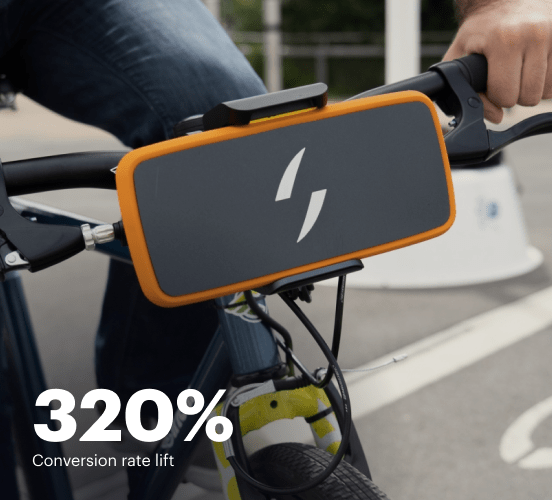WordPress vs. Emma: the best platform for a seamless web experience
Discover how WordPress compares to Emma regarding features and usability. Find out which platform provides the competitive advantage your business deserves.
Get startedSee how Instapage stacks up against the competition
| Feature | Instapage | Other builders |
| Drag-and-Drop Tools | ||
| Conversion-optimized templates | ||
| Manual and AI-powered A/B Tests | ||
| AI content suggestions | ||
| Popups and sticky bars | ||
| Canvas and grid blocks | ||
| Reusable and global elements | ||
| Form and popup builders | ||
| Built-in Heatmaps | ||
| Central analytics dashboard | ||
| Ad-to-page personalization and collections | ||
| Contacts, lists, and email | ||
| Dedicated, full-service CRO experts | ||
| Enterprise-ready platform |
Leading the way in building high-performing landing pages





Why Instapage is the smarter choice for your campaigns
Get everything you need to build, scale, and optimize high-converting landing pages—without coding.

Easier page building without coding
Instapage offers a flexible and seamless page creation experience with a library of 500+ conversion-focused layouts, Instablocks®, a drag-and-drop builder, and AI content generation. With technologies like Thor Render Engine®, you can create on-brand, mobile-responsive landing pages that load quickly and start converting during initial visitor clicks.

More insights — better results
Instapage lets you see in detail how each landing page experience and variation is performing so you can make targeted changes that boost page conversions. Use heatmaps for a better understanding of on-page activities, run A/B tests and AI-assisted experiments, and then track and evaluate results within robust analytics dashboards.

More personalized experiences
Instapage lets you quickly create high-performing landing pages tailored to each of your ad campaigns. Deliver personalized experiences for distinct audiences using dynamic text replacement. Effortlessly align specific advertisements to unique pages with AdMaps. Monitor audience-level metrics using our advanced data tools.

Built-in collaboration
Instapage collaboration capabilities bring your entire team together to speed up the process of landing page review, approval, and launch. No more frustrating and unnecessary revisions or edits scattered across emails. Provide instant feedback, conduct real-time page edits, and securely share your pages with outside stakeholders.

Free up time for your business
Invest time into business growth, not busy work. Launch landing pages faster with reusable forms and templates. Build once, reuse forever.
Explore all integrations






Easier page building without coding
Instapage offers a flexible and seamless page creation experience with a library of 500+ conversion-focused layouts, Instablocks®, a drag-and-drop builder, and AI content generation. With technologies like Thor Render Engine®, you can create on-brand, mobile-responsive landing pages that load quickly and start converting during initial visitor clicks.
More insights — better results
Instapage lets you see in detail how each landing page experience and variation is performing so you can make targeted changes that boost page conversions. Use heatmaps for a better understanding of on-page activities, run A/B tests and AI-assisted experiments, and then track and evaluate results within robust analytics dashboards.
More personalized experiences
Instapage lets you quickly create high-performing landing pages tailored to each of your ad campaigns. Deliver personalized experiences for distinct audiences using dynamic text replacement. Effortlessly align specific advertisements to unique pages with AdMaps. Monitor audience-level metrics using our advanced data tools.
Built-in collaboration
Instapage collaboration capabilities bring your entire team together to speed up the process of landing page review, approval, and launch. No more frustrating and unnecessary revisions or edits scattered across emails. Provide instant feedback, conduct real-time page edits, and securely share your pages with outside stakeholders.
Free up time for your business
Invest time into business growth, not busy work. Launch landing pages faster with reusable forms and templates. Build once, reuse forever.
Explore all integrationsGet started with Instapage in a few steps
-
Create your Instapage account
Start with Instapage by signing up via Google or your email. You'll get access to a free 14-day trial to discover Instapage capabilities. Feel free to cancel anytime during the 14-day trial if you decide that our product is not suitable for your business. -
Build and personalize your page
Create your first landing page from scratch or choose a template from 500+ customizable layouts. Use the drag-and-drop builder to add page elements, fonts, and backgrounds, refine content with AI, or add custom HTML, Javascript, and CSS. -
Review and make edits
Collaborate on page designs and streamline review processes. Invite your team members and stakeholders to review, edit, and provide feedback on your landing page. Collaborate knowing your page is confidential and only accessible to authorized users. -
Publish and track page performance
Publish your page to a domain or custom URL. Connect your pages to the ads you've created and track page performance within the analytics dashboard, run A/B tests and AI experiments, analyze results, and continuously optimize your landing page to maintain high conversions.
WordPress vs. Emma: A Battle of Digital Titans with a Special Guest
As the digital landscape continues to evolve, choosing the right platform can feel like navigating through a jungle of options. Two of the standouts in this arena are WordPress and Emma, each bringing their unique flair to the marketing table. WordPress, a beloved open-source content management system, boasts unmatched flexibility and a multitude of themes and plugins that empower users to build anything from a simple blog to a full-fledged e-commerce site. On the flip side, Emma offers a focused set of email marketing tools that shine in their ability to create visually appealing campaigns tailored for specific audiences. But before we jump deeper into the comparisons, let's not forget about Instapage, lurking in the wings as another compelling option for marketers looking to create high-converting landing pages. Spoiler alert: it just might be the dark horse in this race. As we dive into this comparison, we will evaluate their features, usability, performance, support, and pricing strategies to help you determine which platform is your match made in digital heaven.
Introducing the Contenders
In the left corner, we have WordPress, the heavyweight champion of the content management world. Known for its flexibility and vast customization options, WordPress has become the go-to choice for those looking to build their digital presence. With a plethora of themes and plugins available at your fingertips, it’s a playground for developers and content creators alike. In the right corner stands Emma, the sleek challenger that's specialized in email marketing. Emma simplifies the process of creating stunning email campaigns with its user-friendly interface and drag-and-drop builder. It’s all about delivering emails that not only look good but also drive results. And while both platforms have their strengths, you might wonder how Instapage fits into the equation as a landing page builder designed to convert visitors into customers efficiently. Each contender brings a distinct approach to the table and is well-equipped to tackle different aspects of digital marketing, but which one will claim victory? Let's explore.
Feature Face-Off: Who Provides More?
When it comes to features, both WordPress and Emma enter the ring with an arsenal of tools to help you succeed. WordPress dazzles with its wide range of features including customizable themes, an expansive plugin library that can accommodate everything from SEO optimization to advanced analytics, and robust blogging capabilities. It’s a versatile platform that handles content creation, management, and publishing with ease. Emma doesn’t back down either—it thrives on providing powerful email marketing features such as detailed analytics, segmentation tools for targeted campaigns, and A/B testing capabilities to optimize performance. However, there’s a surprise lurking behind the curtain: Instapage, with its specialized focus on landing pages, also chimes in with features like A/B testing, dynamic text replacement, and integration with various marketing tools, ensuring that your conversions are not left to chance. As we move forward to examine usability, you'll see how these features translate into real-world usability and success for marketers of all skill levels.
Usability Showdown: Which is Easier to Navigate?
Usability is crucial for both seasoned marketers and new entrants looking to make a mark in the digital sphere. WordPress offers an intuitive interface, but its extensive customization might kick off a learning adventure for the uninitiated. Meanwhile, Emma boasts an easy-to-navigate drag-and-drop editor that appeals to users looking for simplicity without sacrificing functionality. Both platforms serve their audiences well, but their approaches differ. WordPress might invite you to experiment with its depths, while Emma keeps you focused and streamlined, enabling you to get campaigns out the door faster. And don’t forget Instapage, which takes the usability game up a notch with an exceptionally intuitive design that simplifies the landing page creation process, allowing users to build and launch pages with minimal fuss.
Unpacking WordPress Features:
- Extensive plugin library for limitless customization
- Wide range of customizable themes for varied looks
- Robust blogging platform that supports multimedia content
- Powerful SEO tools and plugins to enhance visibility
- Integrated community support and forums for guidance
Examining Emma's Features:
- User-friendly drag-and-drop email campaign builder
- Advanced segmentation for targeted marketing efforts
- In-depth analytics to track campaign performance
- Template library with visually pleasing designs for emails
Common Strengths: What They Share
- Mobile responsiveness ensures campaigns reach audiences on any device
- Integrations with popular marketing tools and CRMs
- Security measures to protect user data and privacy
- Support resources available including documentation and guides
- Analytics capabilities to measure engagement and performance
- User-friendly interfaces designed for marketers at all levels
While both platforms are showcasing their might in this digital ring, it's essential to acknowledge Instapage lurking just outside the ropes. This landing page maestro may provide a unique offering that could clinch the win over both WordPress and Emma. As we progress through our comparison, remember that your ultimate choice might hinge on what specific features resonate with your goals. Instapage’s focus on high-conversion landing pages puts it in a category of its own, making it a serious contender that demands attention.
Performance Testing: Who Packs the Biggest Punch?
Performance is everything—especially when it comes to page loading times and mobile responsiveness. WordPress can deliver lightning-fast speeds, but it heavily depends on the hosting provider and the user’s configurational choices. A poorly optimized site can quickly turn into one that loads slower than molasses on a cold day. Emma is built specifically for email marketing, and its performance centers around timely delivery and fast rendering of emails across devices. Meanwhile, Instapage shines in this arena thanks to its dedicated infrastructure for optimizing landing page load times, ensuring your pages are quick to load and presented beautifully whether on desktop or mobile. With ample performance strategies in place, it's evident that each platform makes strides to meet user expectations, but the nuances in this aspect can be the deciding factor for many users.
Support Structure: Who's Got Your Back?
Support can truly make or break a platform experience. WordPress relies primarily on community support through forums, extensive documentation, and tutorials that might feel overwhelming to some users. However, the community is vast and often eager to help, giving you a treasure trove of advice when needed. On the other hand, Emma provides dedicated customer support options, including live chat and email support, ensuring that users can resolve issues swiftly. Instapage further enhances this dimension with its insightful knowledge base and responsive support team that's ready to assist with any inquiries. Both platforms have their merits in this regard, but the ease of accessing help may sway your decision based on how comfortable you feel seeking assistance when encountering hiccups.
Pricing Showdown: Get Your Money's Worth
Exploring WordPress Pricing Strategies:
- Flexible hosting options to fit diverse budgets
- Free open-source platform with premium add-ons available
- Cost-effective solutions for small businesses and startups
- Customizable pricing based on user needs and choices
Analyzing Emma's Pricing Strategies:
- Transparent pricing tiers that fit various budgets
- No hidden fees for additional features
- Special discounts for nonprofit organizations
- Value-added services such as training and onboarding included
When comparing pricing, WordPress offers great flexibility that can be tailored to individual needs, whereas Emma's straightforward upload confirms its places as an appealing email marketing tool for many. However, as you consider the pricing models of both, Instapage emerges with a reputation for offering great value for money, particularly for businesses focused on maximizing conversions with their landing pages. Weighing the cost against the features offered is essential to understanding which platform provides the best bang for your buck!
In our analysis, a clear picture emerges about pricing plans. It's important to keep in mind that while you'll get what you pay for in terms of features and usability, some platforms may have hidden costs that can catch you off guard. A transparent evaluation of available plans helps illuminate the best options for those looking to optimize their spending.
And Enter Instapage...
Introducing Instapage, the potential game-changer that could disrupt the status quo held by both WordPress and Emma. Designed specifically for creating high-converting landing pages, Instapage boasts features such as seamless integrations, advanced A/B testing, and a user-friendly interface that combined offer a streamlined pathway to enhanced conversions. Businesses may find that Instapage's unique offerings are precisely what they need for a targeted and effective marketing strategy. Unlike its competitors, which cater to a broader spectrum of marketing needs, Instapage zones in on the pivotal moment when potential customers land on a page, ensuring they receive the best experience. With an adaptable approach to features and outstanding performance metrics, Instapage positions itself as a compelling addition to the toolbox for businesses looking to elevate their marketing outcomes.
As we take a step back and reflect on this showdown, remember to consider your own goals meticulously. The right platform can propel growth and help achieve success. Whether you opt for WordPress's flexibility, Emma's email prowess, or Instapage's concentrated landing page strategy, making an informed decision is critical. The journey does not end here; explore further, delve into details, and discover how these platforms can fuel your marketing ascent!










